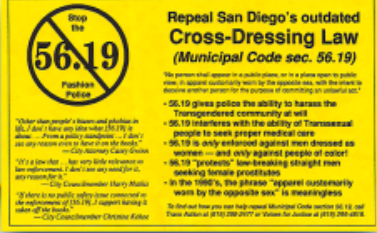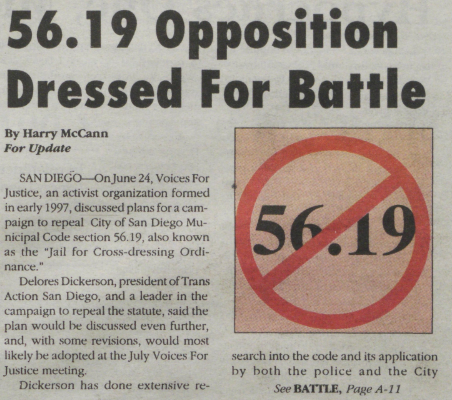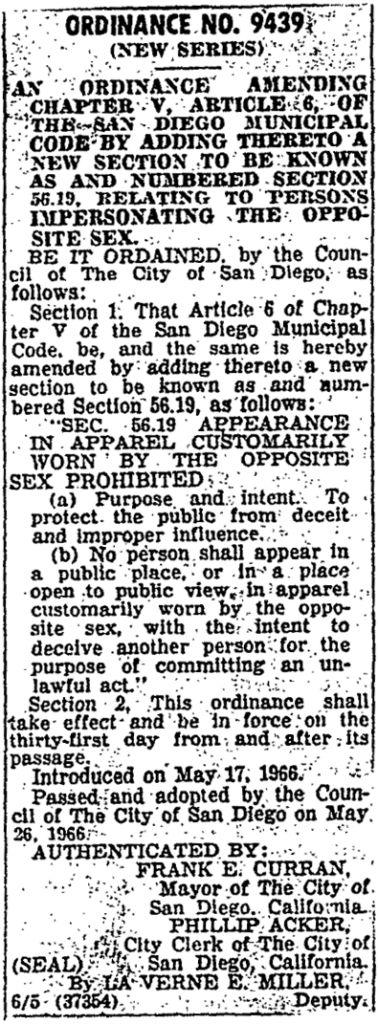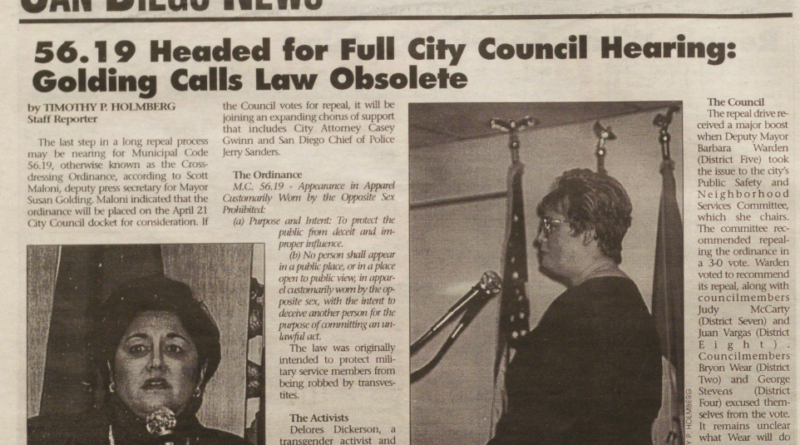For Transgender History Month: How San Diego Activists Defeated a Discriminatory Law
By Nicole Verdes
This August, Lambda Archives was invited to present as part of a monthly Civic Education series hosted by the AJA Project, Our Time to Act, Viet Voices, and Youth Will. We were asked to share insights into San Diego’s LGBTQ+ history, with an intentional focus on local trans history. At a time when trans communities across the country are facing relentless political and cultural attacks, it’s critical to lift up the legacies of resistance, resilience, and organizing—and to ensure these stories are preserved and shared so future generations have the historical context needed to continue the ongoing struggle for trans liberation.
I focused my presentation on the long fight to repeal San Diego’s “Crossdressing Ordinance,” Municipal Code 56.19, adopted by the City Council in 1966. This law made it illegal to appear in public “in apparel customarily worn by the opposite sex, with the intent to deceive.” Though framed as a crime-prevention measure, it was used primarily to target and criminalize trans women and sex workers—particularly Black and Brown women.

The effort to repeal 56.19 was not the work of one person or one moment—it was the result of decades of advocacy, community organizing, legal strategy, and coalition-building. Activists like Delores Dickerson, a trans woman and founding member of the advocacy group Trans Action, played a critical role in organizing support and shifting the public narrative. Trans Action, originally formed to combat employment discrimination, quickly made repeal of the ordinance a top priority. Legal support came from attorney Bridget Wilson, who provided pro bono services, and her law clerk Christine DiEduardo, a trans woman whose painstaking research proved key to demonstrating the ordinance’s discriminatory roots. Others, like Tony Zampella, who served on the City’s Human Relations Commission, helped bring the issue before the Council, while Dr. Kurt Buis from The Center played a hand in the Center becoming a fiscal sponsor for Trans Action.
Together, this coalition chipped away at a deeply entrenched policy—and won. On July 20, 1998, the San Diego City Council voted seven to one to repeal 56.19. The effort was met with resistance, particularly from law enforcement officials who defended the ordinance as a crime-fighting “tool,” and from Councilmember George Stevens, who opposed the repeal on the grounds that crossdressing itself was inherently deceptive. But the tide turned thanks to sustained advocacy and the power of many voices working in unison.

In nearby National City, a similar ordinance—Municipal Code 10.32—prohibited crossdressing while purchasing alcohol, using public restrooms, or “deceiving” others. That ordinance, too, was ultimately repealed thanks to community pressure, led in part by activist Coyote Moon, who reminded us that even laws that go unenforced can serve as potent symbols of exclusion and discrimination.
Today, as we continue to confront the criminalization and stigma that still disproportionately impact trans folks, the lessons of this history remain clear. Change does not happen in a vacuum. It requires strategic organizing, informed legal advocacy, deep community engagement, and the unwavering presence of allies who are willing to fight for our transgender community.

At this year’s Spirit of Stonewall Rally, Courtney Johnson—named Champion of Pride—issued a powerful call to action: “Don’t just stand next to us. Stand in front of us.” When asked to elaborate, Courtney emphasized that cisgender and heterosexual allies, especially those who hold institutional power or access, must take a more visible role in pushing for change. Allyship is not passive; it is active, accountable, and rooted in solidarity.

As we celebrate Transgender History Month, it’s important to acknowledge and hold tight to the fact that the erasure of trans history is not a relic of the past—it is an urgent and ongoing threat. Preserving and sharing these stories is an act of resistance in itself. Trans history is not marginal history. It is foundational. It is powerful. And it must never be forgotten.

